Current Electricity
(B) Electromotive Force, Terminal Voltage and Internal Resistance of a Cell; Combination of Resistors
8.12 Electro-motive Force of Cell
Cell – Two Conductors – Electrolyte – Vessel | Chemical energy | Source of electron | Constant difference in Potential – chemical reaction – continuous flow of charge |

Sulphuric Acid : H2SO4 or H2O4S
Electrolyte : H2SO4 + 2 H2O = SO42- + 2 H3O+
Zn & Cu Both are present ; Zn is more reactive than Cu
So Zn will ionise in preference to Cu
So : Zn → Zinc(2+) + 2e−
Zn → Zn++ + 2 e− Or Zn²⁺ + 2 e−
Copper ions will hungrily and readily gobble up those electrons donated by Zinc
So
Cu²⁺ + 2 e− = Cu
Thus Copper ions get reduced REDCAT So Copper become Cathode
Zinc gives up electron / donates that and thus gets a very positive feeling and becomes positively charged ions .
So Zn starts to have surplus electron ( given up by Portion of it ) and Zn ions go to solution . They dissolve.
Zn electrode becomes Negative and is called Anode ( ICSE Books makes a mistake of convention here and names it cathode )
ε = EMF e.m.f. Electromotive Force
Factors Affecting e.m.f of cell
(1) Material of electrodes : e.g. Zn-Ag or Zn-Cu (2) Electrolyte used in cell : e.g. H2SO4 + 2 H2O or KNO3 + H2O or KCl + H2O
Factors that don’t affect e.m.f. i.e. e.m.f. is independent of
(a) Shape of electrodes (b) the distance between electrode (c) the amount of electrolyte
The salt bridge is a vital component of any voltaic cell. It is a tube filled with an electrolyte solution such as KNO3(s) or KCl(s). The purpose of the salt bridge is to keep the solutions electrically neutral and allow the free flow of ions from one cell to another.
The standard emf of the cell Zn | Zn2+ || Ag+ | Ag is 1.56.
Zn(s) → Zn2+(aq) + 2e and Ni(s) → Ni2+(aq) + 2e
Zn (s) + Ni2+(aq) → Zn2+ (aq) + Ni (s)
Here Zn is in the anode and Cu is in the cathode Ecell =Ecathode‑Eanode therefore ;Ecell=0.34‑(‑0.76) =1.10 V
The Nernst equation enables one to calculate the emf of a cell for any given activities ( concentrations) of ions in solution.
Zn(s)| Zn2+ (C1 ) || Cu2+ (C2 ) | Cu(s)
“LOAN” (left, oxidation, anode, negative).

REDCAT Poses : Right Reduction Cathode Positive ( NPTEL)

8.13 Terminal Voltage of Cell
8.13 Terminal Voltage of Cell
When current is drawn from cell , the cell becomes a closed circuit. In this condition the potential difference between the electrodes of the cell is called terminal voltage.

V = Volt = Terminal Voltage
Terminal Voltage is less than e.m.f of cell
When current flows in cell, some work is spent in moving charges within the electrolyte of the cell . The energy that flows in outer circuit is thus reduced by this amount.
So V = ε – v where v = voltage drop inside the cell V = Voltage difference between terminals at external side
The v = voltage drop depends on current drawn through cell.
So the V available will reduce if you increase the amount of current drawn.
8.14 Internal Restitance of Cell
Electrolyte offers resistance to flow of current inside the cell. This is called internal resistance of the cell.
Due to this resistance when we draw current through cell , the voltage drops from maximum possible.
v = Ir


r = R* ( ε /V- 1)
Factors Affecting Internal Resistance of a Cell
(1) Electrode : Surface area, Increase in surface area reduces the internal resistance.
(2) Electrode : Distance between electrodes . Larger distances increase internal resistance.
(3) Electrolyte : Resistance increases if there is higher concentration of electrolyte | Resistance increase if electrolyte is less ionic e.g. KBr is less ionic than NaCl so KBr will have more resistance than NaCl solution
(4) Temperature : Higher is the temperature of electrolyte, less is the internal resistance ( So In cold weather it becomes difficult to start the car )
8.15 Combination of Resistors
To have desired resistance in an electrical circuit we may connect resistances in three possible ways
(1) Series (2) Parallel (3) Combination of Parallel & Series
(1) Series

Points to be noted
(a) Potential difference : across any resistance is proportional to resistance
(b) Potential difference : across entire circuit is sum of potential difference across individual resistor
V= V1 + V2 + V3
R = R1 + R2 + R3
V = IR = I( R1 + R2 + R3) = IR1 + IR2 + IR3
Rs= nR = Resistance in Series n = number of resistors each of same value R
(2) Parallel

1/Rp = 1/R1 + 1/R2 + 1/R3
Rp = R/n Resistance in Series n = number of resistors each of same value R

Additional reference
hydronium ion, H+ + H2O = H3O+
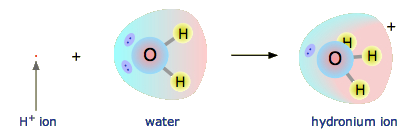
Source : Here
Metal Reactivity Series
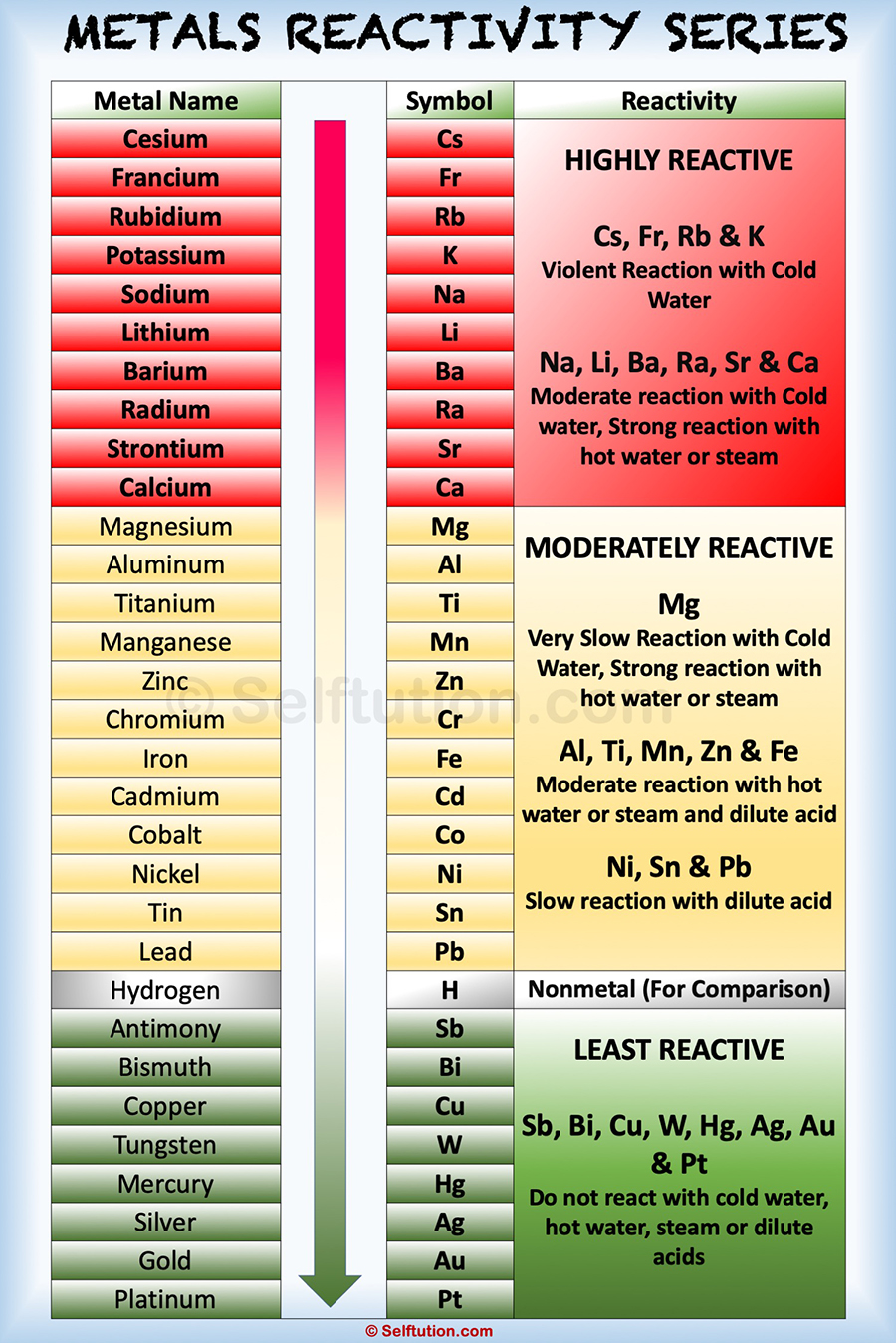
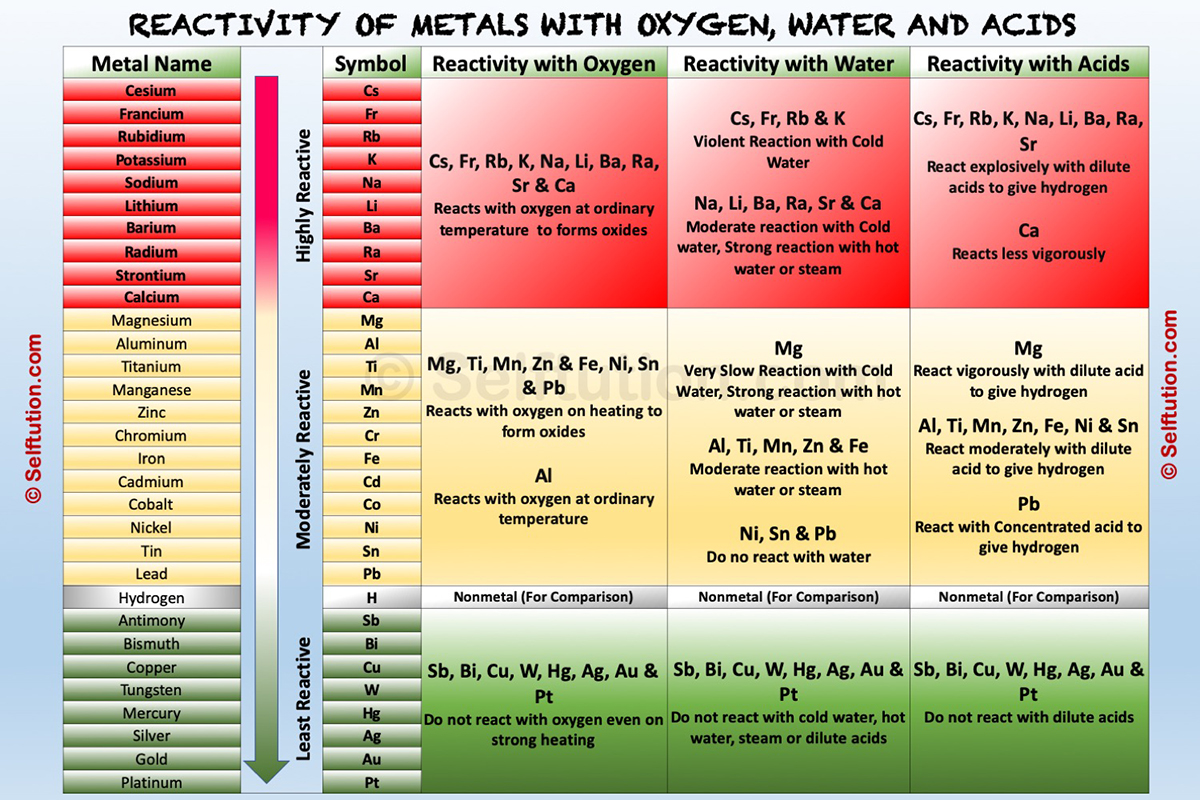

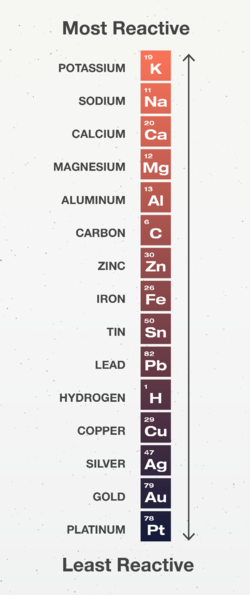


\
Caesium in Water (reaction only)
| Galvanic, Voltaic and Daniell Cell Reactions |
| A galvanic cell is also referred to as a voltaic cell or Daniell cell. The common household battery is an example of a galvanic cell. |


Galvanic cell



Voltaic Cell

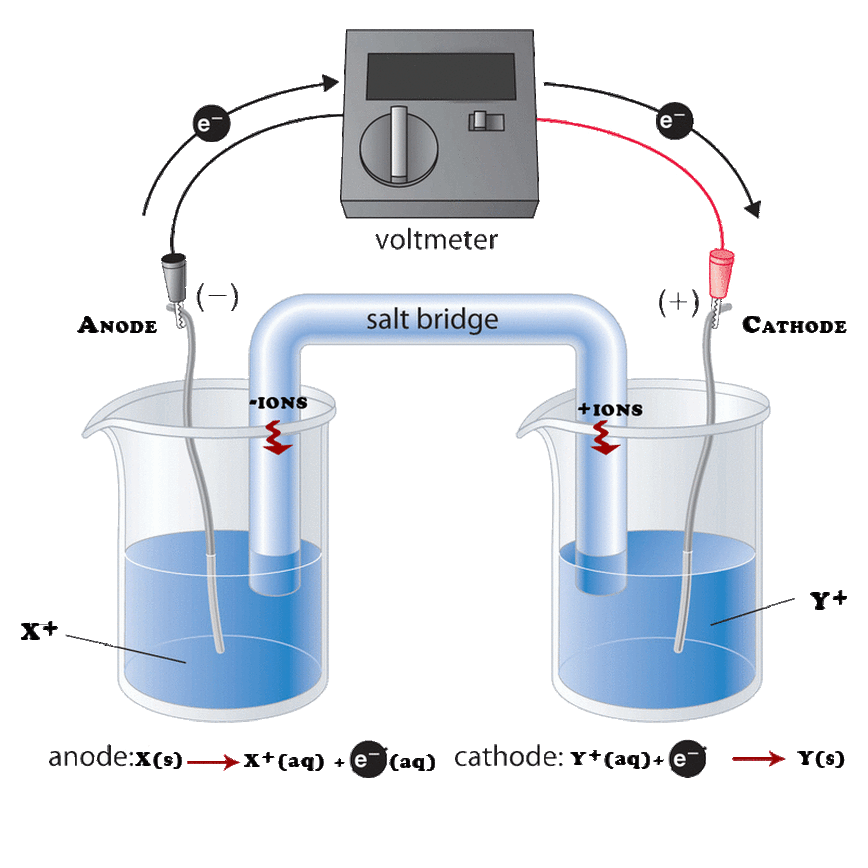
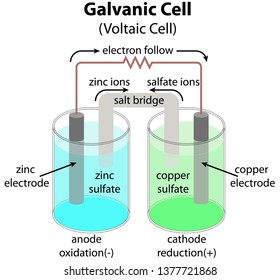
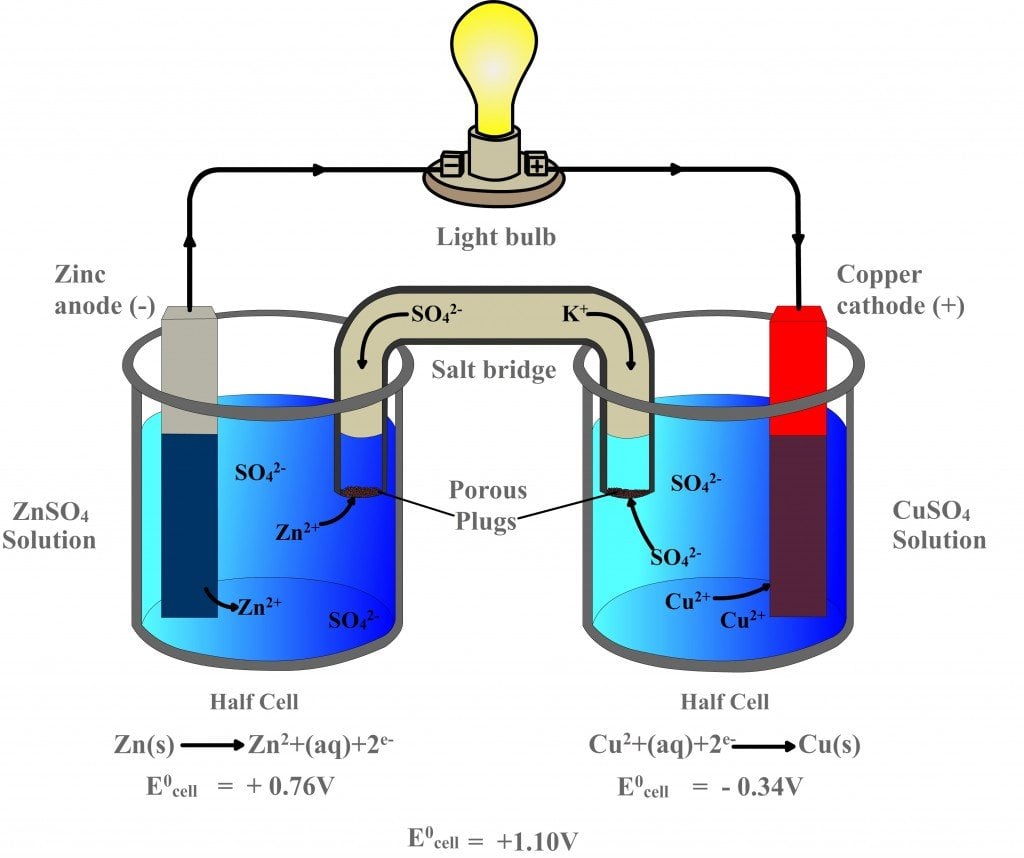
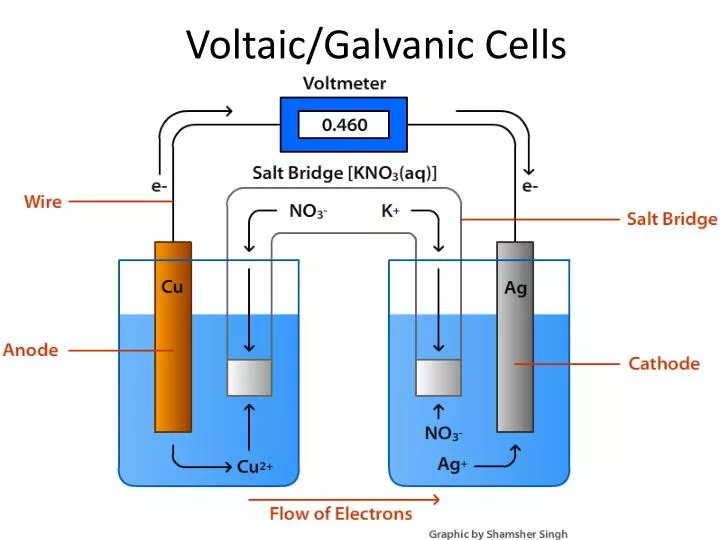




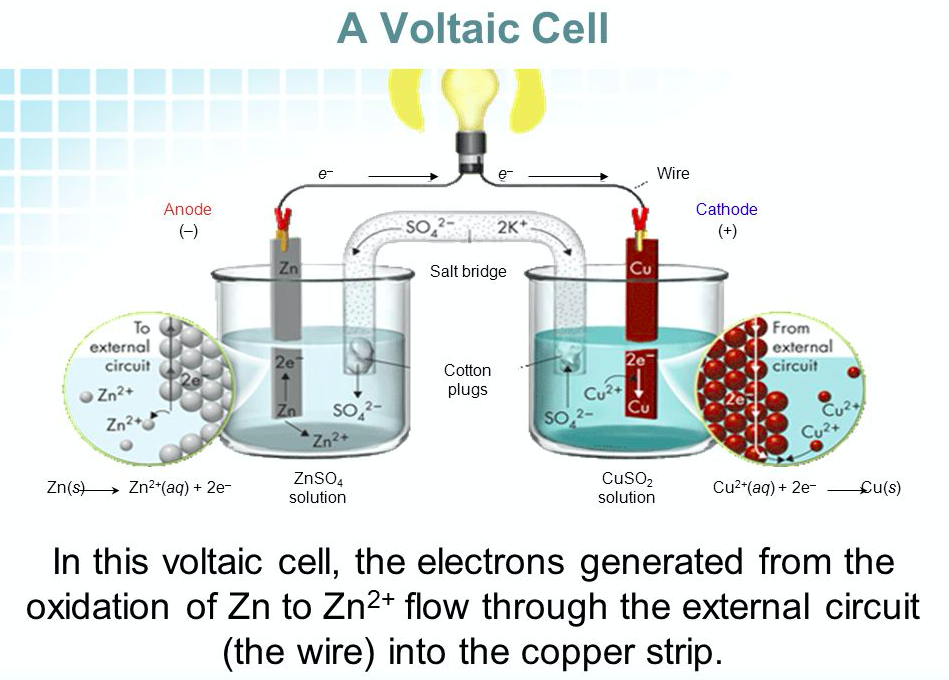

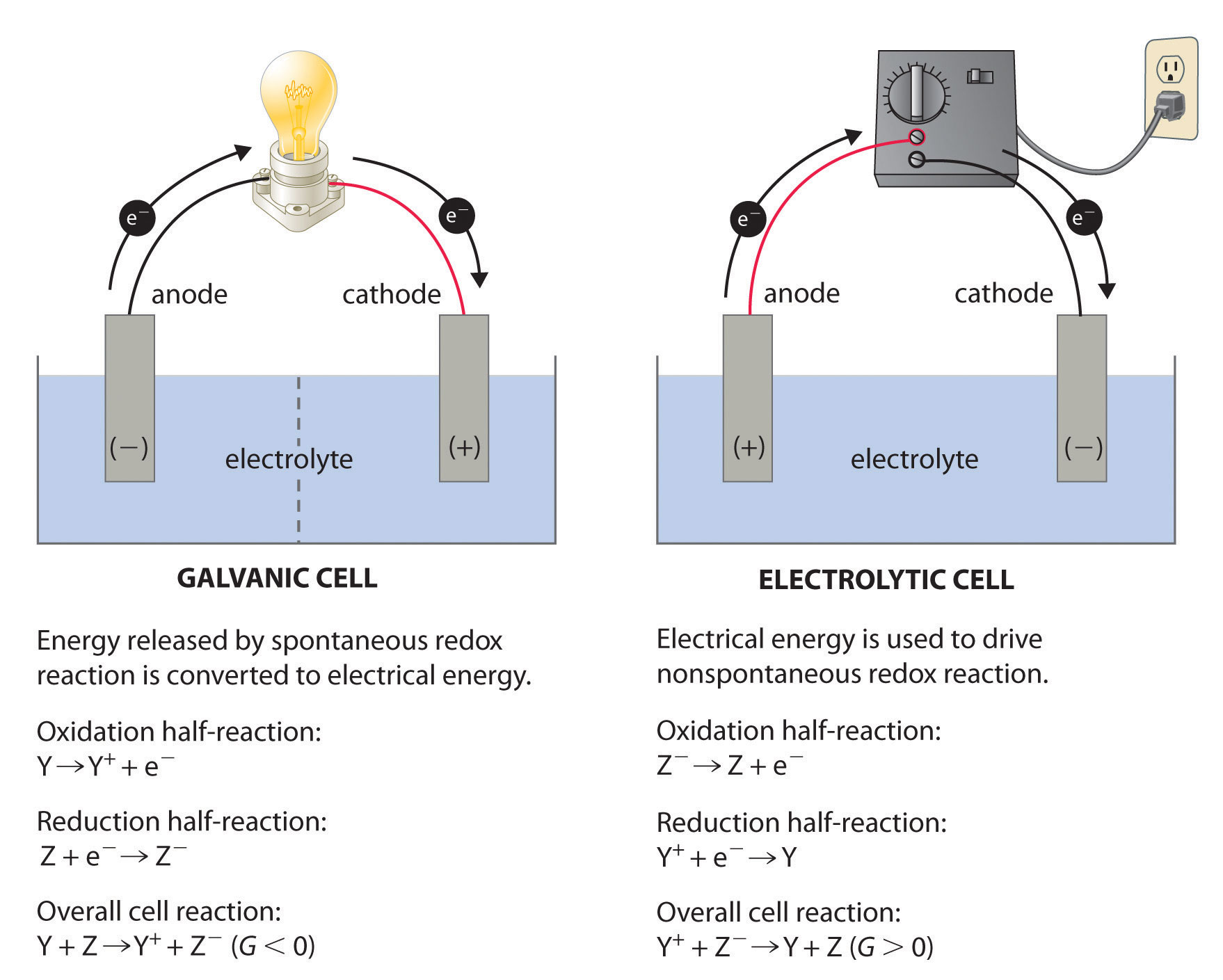
Some Terms
Why Cathode in Battery Cell is Positive & In the electrolytic cell is Negative
REDCAT : Reduction Cathode
Cathode is Negative in Physics ( Electricity Consumed) & Positive in Chemistry ( Electricity Produced)
| Galvanic, Voltaic and Daniell Cell Reactions |
| A galvanic cell is also referred to as a voltaic cell or Daniell cell. The common household battery is an example of a galvanic cell. The flow of electrons from one chemical reaction to another happens through an outside circuit resulting in current. Current is measured in amperes (A) and is a measure of the number of electrons that flow past a certain point in the circuit at any given moment. |
 |
| This is a simple redox reaction in which both cells are combined into one. There is a flow of electrons but not through an outside circuit. |
| One half of the cell is separated from the other by a porous barrier, sometimes called a semi-permeable barrier or by a physical salt bridge like in the diagram below. The metal strips are referred to as electrodes and the dissolved salt solutions are electrolytes. |
 |
| To help remember which electrode does what use the chemist’s mneumonic term “REDCAT” ie. Reduction(RED) occurs at the cathode(CAT), and oxidation occurs at the anode. This is the chemical way of looking at it. |
| Physics people will tell you the cathode is positive(+ve) and the anode is negative (-ve) and electrons flow from the anode to the cathode through an external circuit. |
| Do you see the inherent conflict between these two statements. If reduction occurs at the cathode, then the cathode must have the surplus of electrons, but its’ labelled as being positive (+ve). If the cathode was the surplus then the anode must be deficit in electrons yet it is labelled as negative (-ve). Why is this??? |
| It comes from the old cause and effect concept. We are used to looking at the flow of electrons (electricity) that we almost never stop to see what caused the flow to happen. This is where the science of chemistry comes in. The reasons behind electron flow don’t start with the flow of electrons. It starts with 2 metals, one being stronger in it’s desire for electrons than the other. (ie. bending trees don’t cause the wind to blow either) |
| Lets see if we can clarify this: 1. The metal with the stronger desire for electrons; ie the higher electronegativity, is the one that will be reduced. The metal ions in the electrolyte steal electrons from the metal strip. This causes the metal ions to become reduced to the metal atom. The strip of metal, having lost electrons becomes more positive. |
| 2. The deficit of electrons at the cathode means that there is now a surplus of electrons at the anode. ie. The anode is now negative when compared to the cathode. (This is the physics point of view) |
| 3. Electrons flow from the -ve anode to the +ve cathode to replace those electrons lost to the reduction reaction. |
| 4. As the electron quantity at the anode drops there is an attraction for electrons in the electrode. As electrons get removed from the electrode, metal atoms in the electrode give up their electrons, becoming positive ions, and these positive ions dissolve off into the electrolyte solution. |
| 5. If the salt bridge is not there, the cell that is performing the reduction would become very negative, because the negative anion must remain while all the positive cations are being reduced. The cell that is performing the oxidation will become very positive, because of the formation of positive ions. Eventually this buildup would stop the reactions since the positive cell would build up such a large positive charge that it would start to become more attractive to the electron flow that the original cathode metal electrode. At the same time the buildup of the large negative charge in the cathodic cell would start to repel or oppose the flow of electrons. A salt bridge between the two cells allows a balancing of the electrolytes so that this buildup does not take place. The negative anions from the reduction cell react with the positive cations produced in the oxidation cell neutralizing their charges. |
| To obtain the overall reaction that takes place in the electrochemical cell, the cell reaction, simply add the individual electrode reactions together. Before doing this make sure that the number of electrons gained is equal to the number of electrons lost. This is a requirement that every redox reaction must obey. Multiply the half-reactions by a common multiple in order to achieve this equal number. |
| Na+(aq) + e– –> Na(s) (cathode) Cl–(l) –> Cl2(g) + 2e– (anode) 2 Na+(l) + 2 Cl–(l) + 2e– –> 2 Na(l) + Cl2(g) + 2e– (cell reaction) |
| Then finish the reaction by cancelling out like terms on either side of the —–>. The overall cell reaction is therefore: 2 Na+(l) + 2 Cl–(l) –> 2 Na(l) + Cl2 (g) |
Questions
Source :
Exercise Ex. 8A
Chapter 8 – Current Electricity Exercise Ex. 8A
Question 1
Define the term current and state its S.I. unit.Solution 1
Current is defined as the rate of flow of charge.
I=Q/t
Its S.I. unit is Ampere.Question 1 (MCQ)
Which of the following is an ohmic resistance?
- LED
- Junction diode
- Filament of a bulb
- Nichrome wire
Solution 1 (MCQ)
Nichrome wire is an ohmic resistance.
Hint: Substances that obey Ohm’s law are called Ohmic resistors.Question 1(Num)
In a conductor, 6.25 X 1016 electrons flow from its end A to B in 2 s. Find the current flowing through the conductor ( e= 1.6 X 10 -19 C).Solution 1(Num)

Question 2
Define the term electric potential. State it’s S.I. unit.Solution 2
Electric potential at a point is defined as the amount of work done in bringing a unit positive charge from infinity to that point. Its unit is the volt.Question 2 (MCQ)
For which of the following substances, resistance decreases with increase in temperature?
- Copper
- Mercury
- Carbon
- Platinum
Solution 2 (MCQ)
For carbon, resistance decreases with increase in temperature.
Hint: For semiconductors such as carbon and silicon, the resistance and resistivity decreases with the increase in temperature.Question 2 (Num)
A current of 1.6 mA flows through a conductor. If charge of an electron is -1.6 x 10-19 coulomb, find the number of electrons that will pass each second through the cross section of that conductor.Solution 2 (Num)
Current , I = 1.6 mA = 1.6 x 10-3 A
Charge, Q = -1.6 x 10-19 coulomb
t=1 sec
I = Q/t
Q = I x t
Q = 1.6 x 10-3 x 1
No. of electrons = 1.6 x 10-3/1.6 x 10-19
=1016Question 3
How is the electric potential difference between the two points defined? State its S.I. unit.Solution 3
The potential difference between two points is equal to the work done in moving a unit positive charge from one point to the other.
It’s S.I. unit is Volt.Question 3 (Num)
Find the potential difference required to pass a current of 200 mA in a wire of resistance 20 ohm.Solution 3 (Num)
Current (I) = 200 mA
Resistance (R) = 20 ohm
Potential Difference (V) = ?
According to Ohm’s Law :
V = IR
V = 200 x 20 = 4 VQuestion 4
Explain the statement ‘the potential difference between two points is 1 volt’.Solution 4
One volt is the potential difference between two points in an electric circuit when 1 joule of work is done to move charge of 1 coulomb from one point to other.Question 4 (Num)
An electric bulb draws 1.2 A current at 6.0 V. Find the resistance of filament of bulb while glowing.Solution 4 (Num)
Current (I) = 1.2 A
Potential Difference/Voltage (V) = 6.0 V
Resistance (R) = ?
According to Ohm’s Law :
V=IR
Then R = V/I
R = 6 / 1.2
R = 5 OhmQuestion 5
- State whether the current is a scalar or vector? What does the direction of current convey?
- State whether the potential is a scalar or vector? What does the positive and negative sign of potential convey?
Solution 5
a. Current is a scalar quantity. The direction of current conveys that the flow of electrons is opposite to the direction of flow of current.
b. Potential is also a scalar quantity. The positive sign of potential conveys that work has to be done on the positive test charge against the repulsive force due to the positive charge in bringing it from infinity. The negative sign of potential conveys that work is done on the negative test charge by the attractive force.Question 5 (Num)
A car bulb connected to a 12 volt battery draws 2 A current when glowing. What is the resistance of the filament of the bulb? Will the resistance be more, same or less when the bulb is not glowing.Solution 5 (Num)
Potential Difference/Voltage (V) = 12 V
Current (I) = 2 A
Resistance (R) = ?
According to Ohm’s Law :
V=IR
Then R = V/I
R = 12 / 2
R = 6 Ohm
Resistance will be less when the bulb is not glowing.Question 6
Define the term resistance. State it’s S.I. unit.Solution 6
It is the property of a conductor to resist the flow of charges through it. It’s S.I. unit is Ohm.Question 6 (Num)
Calculate the current flowing through a wire of resistance 5 W connected to a battery of potential difference 3 V.Solution 6 (Num)
Potential Difference/Voltage (V) = 3 V
Resistance (R) = 5 ohm
Current (I) = ?
According to Ohm’s Law :
V=IR
Then I = V/R
I=3/5 =0.6 AQuestion 7
(a) Name the particles which are responsible for the flow of current in a metallic wire.
(b) Explain the flow of current in a metallic wire on the basis of movement of the particles named by you above in part
(c) What is the cause of resistance offered by the metallic wire in the flow of current through it?Solution 7
(a) Particles responsible for the flow of current in a metallic wire are free electrons.
(b) In metals, free electrons are the moving charges that result in the conduction of electricity. If ‘n’ electrons pass through the metallic conductor in time ‘t’, then the total charge that has flown is given by Q (charge) = n x e (charge on an electron).
(c) A metal includes free electrons and fixed positive ions.
Positive ions give away their valence electrons and thus attain a positive charge.
Electrons are free for movement, but positive ions do not move; thus, when a potential difference is applied across the circuit, and when free electrons begin to move, they collide with these fixed ions.
This collision is the major cause of resistance offered by the metallic wire in the flow of current through it.Question 7 (Num)
In an experiment of verification of Ohm’s law, following observations are obtained.
| Potential difference V (in volt) | 0.5 | 1.0 | 1.5 | 2.0 | 2.5 |
| Current I (in amp) | 0.2 | 0.4 | 0.6 | 0.8 | 1.0 |
Draw a characteristic V-I graph and use this graph to find :
(a) potential difference V when the current I is 0.5 A.
(b) current I when the potential difference V is 0.75 V.
(c) resistance in circuitSolution 7 (Num)
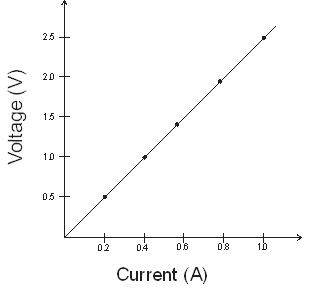
(a) 1.25 V
(b) 0.3 A
(c) The graph is linear so resistance can be found from any value of the given table. For instance :
When V=2.5 Volt
Current is I=1.0 amp
According to ohm’s law :
R=V/I
R=2.5/1.0 = 2.5 ohmQuestion 8
State Ohm’s law and draw a neat labelled circuit diagram containing a battery, a key, a voltmeter, an ammeter, a rheostat and an unknown resistance to verify it.Solution 8
It states that electric current flowing through a metallic wire is directly proportional to the potential difference V across its ends provided its temperature remains the same. This is called Ohm’s law.
V = IR

Question 8 (Num)
Two wires of the same material and same length have radii 1 mm and 2 mm respectively. Compare (i) their resistances (ii) their resistivities.Solution 8 (Num)
(i)For wire of radius r1 :

(ii)For wire of radius r2 :


(ii) Since the material of the two wires is same, so their resistivities will also be same i.e., ![]() Question 9
Question 9
(a) Name and state the law which relates the potential difference and current in a conductor.
(b) What is the necessary condition for a conductor to obey the law named above in part (a)?Solution 9
(a)The law is called Ohm’s law. It states that the current flowing through the conductor is directly proportional to the potential difference across the ends of a conductor given the temperature remains constant.
(b) Temperature should remain constant.Question 9(Num)
A given wire of resistance 1 is stretched to double its length. What will be its new resistance?Solution 9(Num)

Question 10
(a) Draw a V-I graph for a conductor obeying Ohm’s law.
(b) What does the slope of V-I graph for a conductor represent?Solution 10
(a)
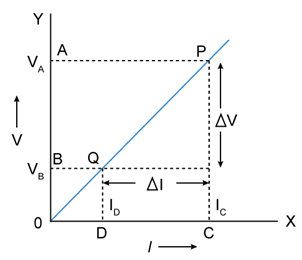
(b) Slope of VI graph represents the resistance.Question 10 (Num)
A wire of 3 ohm resistance and 10 cm length is stretched to 30 cm length. Assuming that what it has a uniform cross-section, what will be its new resistance?Solution 10 (Num)
Resistance (R) = 3 ohm
Length l = 10 cm
New Length (l’) = 30 cm = 3 x l

New Resistance :
With stretching length will increase and area of cross-section will decrease in the same order

Therefore,

Question 11
Draw an I – V graph for a linear resistor. What does its slope represent?Solution 11
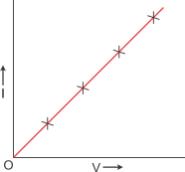
The slope of I-V graph (=) is equal to the reciprocal of the resistance of the conductor, i.e.

Question 11 (Num)
A wire of 9 ohm resistance having 30 cm length is tripled on itself. What is its new resistance?Solution 11 (Num)
Resistance (R) = 9 ohm
Length l = 30 cm
New Length (![]() ) = 30 cm = 3/l = 10 cm
) = 30 cm = 3/l = 10 cm

New Resistance :
With change in length, there will be change in area of cross-section also in the same order.

R’ = 1 ohmQuestion 12
What is an ohmic resistor? Give one example of an ohmic resistor. Draw a graph to show its current – voltage relationship. How is the resistance of the resistor determined from this graph?Solution 12
Ohmic Resistor: An ohmic resistor is a resistor that obeys Ohm’s law. For example: all metallic conductors (such as silver, aluminium, copper, iron etc.)
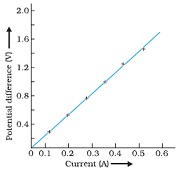
From above graph resistance is determined in the form of slope.Question 12 (Num)
What length of copper wire of resistivity 1.7 x 10-8 Wm and radius 1 mm is required so that its resistance is 1W.Solution 12 (Num)
Resistance (R) = 1 ohm
Resistivity (![]() ) = 1.7 x 10-8 ohm metre
) = 1.7 x 10-8 ohm metre
Radius (r) = 1 mm = 10-3 m
Length (l) = ?

Question 13
What are non-ohmic resistors? Give one example and draw a graph to show its current-voltage relationship.Solution 13
The conductors which do not obey Ohm’s Law are called non-ohmic resistors. Example: diode valve.
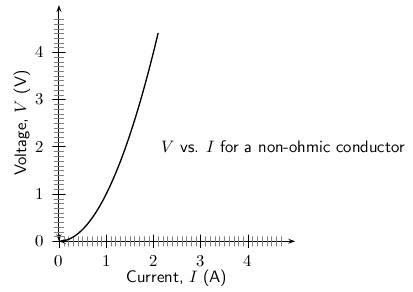
Question 13(Num)
The filament of a bulb takes a current 100 mA when potential difference across it is 0.2 V. When the potential difference across it becomes 1.0 V, the current becomes 400 mA. Calculate the resistance of filament in each case and account for the difference.Solution 13(Num)
According to Ohm’s law,

Resistance of the wire increases with increase in temperature. So the difference arises because the temperature of the filament increased.Question 14
Give two differences between an ohmic and non-ohmic resistor.Solution 14
(1) Ohmic resistor obeys ohm’s law i.e., V/I is constant for all values of V or I; whereas Non-ohmic resistor does not obey ohm’s law i.e., V/I is not same for all values of V or I.
(2) In Ohmic resistor, V-I graph is linear in nature whereas in non-ohmic resistor, V-I graph is non-linear in nature.Question 15
Fig. below shows the I-V characteristic curves for two resistors. Identify the ohmic and non-ohmic resistors. Give a reason for your answer.
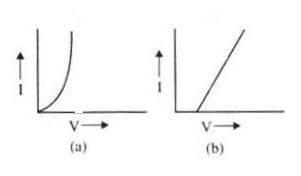
Solution 15
Ohmic: (b), Non-Ohmic: (a)
Only for (a) the I-V graph is a straight line or linear while for (a), the graph is a curve.Question 16
Draw a V – I graph for a conductor at two different temperatures. What conclusion do you draw from your graph for the variation of resistance of conductor with temperature?Solution 16
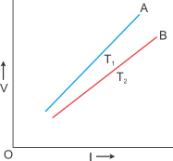
In the above graph, T1 T2. The straight line A is steeper than the line B, which leads us to conclude that the resistance of conductor is more at high temperature T1 than at low temperature T2. Thus, we can say that resistance of a conductor increases with the increase in temperature.Question 17(a)
How does the resistance of a wire depend on its radius? Explain your answer.Solution 17(a)
Resistance of a wire is inversely proportional to the area of cross-section of the wire.


This means if a wire of same length, but of double radius is taken, its resistance is found to be one-fourth.Question 17(b)
Two copper wires are of same length, but one is thicker than the other. Which will have more resistance?Solution 17(b)
Resistance is directly proportional to the length and inversely proportional to the area of cross-section. The thicker wire has more area, and hence the resistance of the other wire will be more than that of the thicker wire.Question 18
How does the resistance of a wire depend on its length? Give a reason of your answer.Solution 18
Resistance of a wire is directly proportional to the length of the wire.

The resistance of a conductor depends on the number of collisions which the electrons suffer with the fixed positive ions while moving from one end to the other end of the conductor. Obviously the number of collisions will be more in a longer conductor as compared to a shorter conductor. Therefore, a longer conductor offers more resistance.Question 19
How does the resistance of a metallic wire depend on its temperature? Explain with reason.Solution 19
With the increase in temperature of conductor, both the random motion of electrons and the amplitude of vibration of fixed positive ions increase. As a result, the number of collisions increases. Hence, the resistance of a conductor increases with the increase in its temperature.
The resistance of filament of a bulb is more when it is glowing (i.e., when it is at a high temperature) as compared to when it is not glowing (i.e., when it is cold).Question 20
Two wires, one of copper and other of iron, are of the same length and same radius. Which will have more resistance? Give reason.Solution 20
Iron wire will have more resistance than copper wire of the same length and same radius because resistivity of iron is more than that of copper.Question 21
Name three factors on which the resistance of a wire depends and state how it is affected by the factors stated by you?Solution 21
(i) Resistance of a wire is directly proportional to the length of the wire means with the increase in length resistance also increases.

(ii) Resistance of a wire is inversely proportional to the area of cross-section of the wire. If area of cross-section of the wire is more, then resistance will be less and vice versa.

(iii) Resistance increases with the increase in temperature since with increase in temperature the number of collisions increases.
(iv) Resistance depends on the nature of conductor because different substances have different concentration of free electrons.Substances such as silver, copper etc. offer less resistance and are called good conductors; but substances such as rubber, glass etc. offer very high resistance and are called insulators.Question 22
Define the term specific resistance and state its S.I. unit.Solution 22
The resistivity of a material is the resistance of a wire of that material of unit length and unit area of cross-section.
Its S.I. unit is ohm metre.Question 23
Write an expression connecting the resistance of a wire and specific resistance of its material. State the meaning of symbols used.Solution 23
Expression :

![]() – resistivity
– resistivity
R – resistance
l – length of conductor
A – area of cross-csectionQuestion 24
State the order of specific resistance of (i) a metal, (ii) a semiconductor and (iii) an insulator.Solution 24
Metal < Semiconductor < InsulatorQuestion 25
(a) Name two factors on which the specific resistance of a wire depends?
(b) Two wires A and B are made of copper. The wire A is long and thin while the wire B is Short and thick. Which will have more specific resistance ?Solution 25
(a) The specific resistance of a wire depends on the material of the substance and the temperature of the substance.
(b) Specific resistance depends on the material of the wire and not its dimensions. Hence, both the wires will have the same specific resistance .Question 26
Name a substance of which the specific resistance remains almost unchanged by the increase in temperature.Solution 26
ManganinQuestion 27
How does specific resistance of a semi-conductor change with the increase in temperature?Solution 27
Specific resistance of a semiconductor decreases with increase in temperature. Question 28
How does (a) resistance, and (b) specific resistance of a wire depend on its (i) length, and (ii) radius?Solution 28
Resistance is directly proportional to the length and inversely proportional to the square of radius. Specific resistance is independent on the dimensions of a wire.Question 29
(a) Name the material used for making the connection wires. Give reason for your answer.
(b) Why should a connection wire be thick?Solution 29
(a) The materials used for making connection wires are copper or aluminium. These materials are chosen because they have small specific resistance.
(b) A connection wire should be thick so that it offers negligible resistance to the flow of current through the circuit.Question 30
Name a material which is used for making the standard resistor. Give a reason for your answer.Solution 30
Manganin is used for making the standard resistor because its resistivity is quite large and the effect of change in temperature on their resistance is negligible.Question 31
Name the material used for making a fuse wire. Give a reason.Solution 31
Generally fuse wire is made of an alloy of lead and tin because its resistivity is high and melting point is low.Question 32
Name the material used for:
- Filament of an electric bulb
- Heating element of a room heater
Solution 32
(i) A wire made of tungsten is used for filament of electric bulb because it has a high melting point and high resistivity.
(ii) A nichrome wire is used as a heating element for a room heater because the resistivity of nichrome is high and increase in its value with increase in temperature is high.Question 33
What is a superconductor? Give one example of it.Solution 33
A superconductor is a substance of zero resistance at a very low temperature. Example: Mercury at 4.2 K.Question 34
A substance has zero resistance below 1 K. What is such a substance called?Solution 34
Superconductor
Exercise Ex. 8B
Chapter 8 – Current Electricity Exercise Ex. 8B
Question 1
Explain the meaning of the terms e.m.f., terminal voltage and internal resistance of cell.Solution 1
e.m.f.: When no current is drawn from a cell, the potential difference between the terminals of the cell is called its electro-motive force (or e.m.f.).
Terminal voltage: When current is drawn from a cell, the potential difference between the electrodes of the cell is called its terminal voltage.
Internal Resistance: The resistance offered by the electrolyte inside the cell to the flow of electric current through it is called the internal resistance of the cell.Question 1 (MCQ)
In series combination of resistances:
- P.d. is same across each resistance
- Total resistance is reduced
- Current is same in each resistance
- All of the above are true
Solution 1 (MCQ)
In series combination of resistances, current is same in each resistance.
Hint: In a series combination, the current has a single path for its flow. Hence, the same current passes through each resistor.Question 1 (Num)
The diagram below in fig. shows a cell of emf ![]() =2 volt and internal resistance r = 1 ohm to an external resistance R=4 ohm. The ammeter A measure the current in the circuit and the voltmeter V measures the terminal voltage across the cell. What will be the readings of the ammeter and the voltmeter when (i) key K is open (ii) key K is closed
=2 volt and internal resistance r = 1 ohm to an external resistance R=4 ohm. The ammeter A measure the current in the circuit and the voltmeter V measures the terminal voltage across the cell. What will be the readings of the ammeter and the voltmeter when (i) key K is open (ii) key K is closed
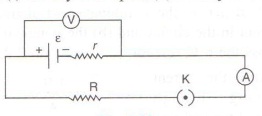
Solution 1 (Num)
(i) Ammeter reading = 0 because of no current
Voltage V = ![]() – Ir
– Ir
V = 2 – 0 x 1 = 2 volt
(ii) Ammeter reading :
I=![]() /(R+r)
/(R+r)
I=2 / (4+1) = 2 / 5 = 0.4 amp
Voltage reading :
Voltage V = ![]() – Ir
– Ir
V=2 – 0.4 x 1 = 2 – 0.4 = 1.6 VQuestion 2
State two differences between the e.m.f. and terminal voltage of a cell.Solution 2
| e.m.f. of cell | Terminal voltage of cell |
| 1.It is measured by the amount of work done in moving a unit positive charge in the complete circuit inside and outside the cell. | 1. It is measured by the amount of work done in moving a unit positive charge in the circuit outside the cell. |
| 2.It is the characteristic of the cell i.e., it does not depend on the amount of current drawn from the cell | 2. It depends on the amount of current drawn from the cell. More the current is drawn from the cell, less is the terminal voltage. |
| 3.It is equal to the terminal voltage when cell is not in use, while greater than the terminal voltage when cell is in use. | 3. It is equal to the emf of cell when cell is not in use, while less than the emf when cell is in use. |
Question 2 (MCQ)
In parallel combination of resistances:
- P.D. is same across each resistance
- Total resistance is increased
- Current is same in each resistance
- All of the above are true
Solution 2 (MCQ)
In parallel combination of resistances, P.D. is same across each resistance.
Hint: In parallel combination, the ends of each resistor are connected to the ends of the same source of potential. Thus, the potential difference across each resistance is same and is equal to the potential difference across the terminals of the source (or battery).Question 2 (Num)
A battery of e.m.f. 3.0 V supplies current through a circuit in which resistance can be changed. A high resistance voltmeter is connected across the battery. When the current is 1.5 A, the voltmeter reads 2.7 V. Find the internal resistance of the battery.Solution 2 (Num)
![]() = 3 volt
= 3 volt
I = 1.5 A
V=2.7 V
V = ![]() – Ir
– Ir
r=(e-V) / I
= (3 – 2.7) / 1.5 = 0.2 ohmQuestion 3
Name two factors on which the internal resistance of a cell depends and state how does it depend on the factors stated by you.Solution 3
Internal resistance of a cell depends upon the following factors:
(i) The surface area of the electrodes: Larger the surface area of the electrodes, less is the internal resistance.
(ii) The distance between the electrodes: More the distance between the electrodes, greater is the internal resistance.Question 3 (MCQ)
Which of the following combinations have the same equivalent resistance between X and Y?
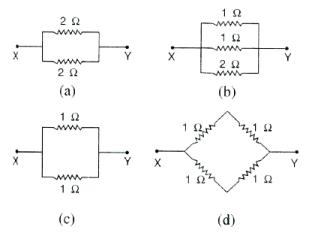
Solution 3 (MCQ)
(a) and (d)
Solution:

Question 3 (Num)
A cell of emf 1.8 V and internal resistance 2 ohm is connected in series with an ammeter of resistance 0.7 ohm and resistance of 4.5 ohm as shown in figure.
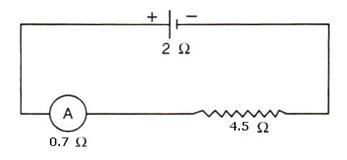
(a) What would be the reading of the ammeter?
(b) What is the potential difference across the terminals of the cell?Solution 3 (Num)
(a) ![]() = 1.8 V
= 1.8 V
Total Resistance = 2 + 4.5 + 0.7 = 7.2 W
I=?
I=![]() / R (total resistance)
/ R (total resistance)
I = 1.8 / 7.2 = 0.25 A
(b) Current (calculated in (a) part) I = 0.25 A
Now, total resistance excluding internal resistance = 4.5 + 0.7 = 5.2 ohm
V = IR = 0.25 x 5.2 = 1.3 VQuestion 4
A cell of emf ![]() and internal resistance r is used to send current to an external resistance R. Write expressions for (a) the total resistance of the circuit (b) the current drawn from the cell and (c) the p.d. across the cell (d) voltage drop inside the cell.Solution 4
and internal resistance r is used to send current to an external resistance R. Write expressions for (a) the total resistance of the circuit (b) the current drawn from the cell and (c) the p.d. across the cell (d) voltage drop inside the cell.Solution 4
(a) Total resistance = R + r
(b) Current drawn from the circuit :
As we know that,
![]() =V+v
=V+v
= IR + Ir
=I(R+r)
I = e / (R + r)
(c) p.d. across the cell : ![]()
(d) voltage drop inside the cell: ![]() Question 4 (Num)
Question 4 (Num)
A battery of emf 15 V and internal resistance 3 ohm is connected to two resistors of resistances 3 ohm and 6 ohm in series. Find :
(a) the current through the battery
(b) the p.d. between the terminals of the battery.Solution 4 (Num)
(a) ![]() = 15 V
= 15 V
R=6+3 = 9 ohm
r = 3 ohm
I=?
I=![]() / (R+r)
/ (R+r)
I = 15 / (9+3) = 15/12 = 1.25 A
(b) Current (calculated in (a) part) I = 1.25 A
External Resistance R = 6 + 3 = 9 ohm
V = IR = 1.25 x 9 = 11.25 VQuestion 5
A cell is used to send current to an external circuit. (a) How does the voltage across its terminal compare with its emf? (b) Under what condition is the emf of a cell equal to its terminal voltage?Solution 5
(a) Terminal voltage is less than the emf : Terminal Voltage < e.m.f.
(b) e.m.f. is equal to the terminal voltage when no current is drawn.Question 5 (Num)
A cell of emf ![]() and internal resistance r sends current 1.0 A when it is connected to an external resistance 1.9 ohm. But its sends current 0.5 A when it is connected to an external resistance of 3.9 ohm. Calculate the values of e and r.Solution 5 (Num)
and internal resistance r sends current 1.0 A when it is connected to an external resistance 1.9 ohm. But its sends current 0.5 A when it is connected to an external resistance of 3.9 ohm. Calculate the values of e and r.Solution 5 (Num)
In first case
I=1 A, R=1.9 ohm
![]() =I(R+r)=1(1.9+r)
=I(R+r)=1(1.9+r)
![]() =1.9+r————(1)
=1.9+r————(1)
In second case
I=0.5 A, R=3.9 ohm
![]() =I(R+r)=0.5(3.9+r)
=I(R+r)=0.5(3.9+r)
![]() =1.95+0.5r—————-(2)
=1.95+0.5r—————-(2)
From eq. (1) and (2),
1.9+r=1.95+0.5r
r=0.05/0.5=0.1 ohm
Substituting value of r
![]() =1.9+r=1.9+0.1=2 VQuestion 6
=1.9+r=1.9+0.1=2 VQuestion 6
Explain why the p.d. across the terminals of a cell is more in an open circuit and reduced in a closed circuit.Solution 6
When the electric cell is in a closed circuit the current flows through the circuit. There is a fall of potential across the internal resistance of the cell. So, the p.d. across the terminals in a closed circuit is less than the p.d. across the terminals in an open circuit by an amount equal to the potential drop across the internal resistance of the cell.Question 6(Num)
Two resistors having resistance 4 and 6 are connected in parallel. Find their equivalent resistance.Solution 6(Num)

Question 7
Write the expressions for the equivalent resistance R of three resistors R1, R2 and R3 joined in (a) parallel, (b) series.Solution 7
(a) Total Resistance in series:

(b) Total Resistance in parallel:

Question 7 (Num)
Four resistors each of resistance 2 ohm are connected in parallel. What is the effective resistance?Solution 7 (Num)
R1 = 2 ohm
R2 = 2 ohm
R3 = 2 ohm
R4 = 2 ohm

Question 8
How would you connect two resistors in series? Draw a diagram. Calculate the total equivalent resistance.Solution 8
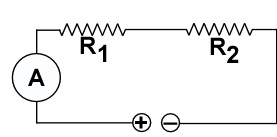
If current I is drawn from the battery, the current through eac resistor will also be I.
On applying Ohm’s law to the two resistors separately, we further
have
V1 = I R1
V2 = I R2
V=V1 + V2
IR = I R1+ I R2
R= R1+ R2
Total Resistance in series R :

Question 8(Num)
You have three resistors of values 2, 3 and 5. How will you join them so that the total resistance is less than 1 ? Draw diagram and find the total resistance.Solution 8(Num)

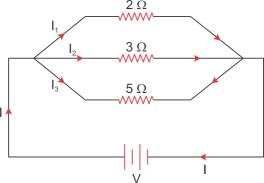

Question 9
Show by a diagram how two resistors R1 and R2 are joined in parallel. Obtain an expression for the total resistance of the combination.Solution 9
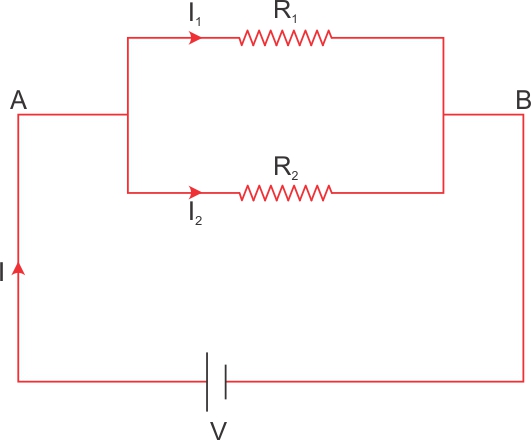
On applying Ohm’s law to the two resistors separately, we further
Have
I1 = V / R1
I2 = V / R2
I = I1 + I2

Question 9 (Num)
Three resistors each of 2 W are connected together so that their total resistance is 3 W. Draw a diagram to show this arrangement and check it by calculation.Solution 9 (Num)
A parallel combination of two resistors, in series with one resistor.
R1 = 2 ohm
R2 = 2 ohm
R3 = 2 ohm

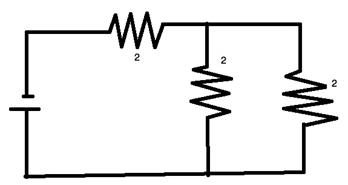
Question 10
State how are the two resistors are joined with a battery in each of the following cases when:
(a) same current flows in each resistor
(b) potential difference is same across each resistor.
(c) equivalent resistance is less than either of the two resistances.
(d) equivalent resistance is more than either of the two resistances.Solution 10
(a) series
(b) parallel
(c) parallel
(d) seriesQuestion 10 (Num)
Calculate the equivalent resistance between the points A and B in figure if each resistance is 2.0 Ω .

Solution 10 (Num)
For parallel resistances

Therefore

Question 11
The V-I graph for a series combination and for a parallel combination of two resistors is shown in fig. Which of the two, A or B, represents the parallel combination? Give a reason for your answer.
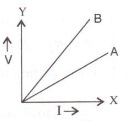
Solution 11
For the same change in I, change in V is less for the straight line A than for the straight line B (i.e., the straight line A is less steeper than B), so the straight line A represents small resistance, while the straight line B represents more resistance. In parallel combination, the resistance decreases while in series combination, the resistance increases. So A represents the parallel combination.Question 11 (Num)
A combination consists of three resistors in series. Four similar sets are connected in parallel. If the resistance of each resistor is 2 ohm, find the resistance of the combination.Solution 11 (Num)
Resistance of each set :
r1 = 2 + 2 + 2 = 6 ohm
r2 = 2 + 2 + 2 = 6 ohm
r3 = 2 + 2 + 2 = 6 ohm
r4 = 2 + 2 + 2 = 6 ohm
Now these resistances are arranged in parallel :

Question 12 (Num)
In the circuit shown below in figure, calculate the value of x if the equivalent resistance between A and B is 4 W.

Solution 12 (Num)
r1 = 4 ohm
r2 = 8 ohm
r3 = x ohm
r4 = 5 ohm
r=4 ohm

Question 13(Num)
Calculate the effective resistance between the points A and B in the circuit shown in Fig.
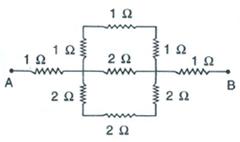
Solution 13(Num)
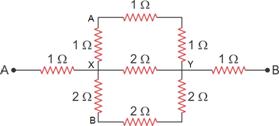

Question 14 (Num)
A wire of uniform thickness with a resistance of 27 ohm is cut into three equal pieces and they are joined in parallel. Find the resistance of the parallel combination.Solution 14 (Num)
Wire cut into three pieces means new resistance = 27/3 = 9
Now three resistance connected in parallel :

Question 15 (Num)
A circuit consists of a 1 ohm resistor in series with a parallel arrangement of 6 ohm and 3 ohm resistors. Calculate the total resistance of the circuit. Draw a diagram.Solution 15 (Num)


Question 16(Num)
Calculate the effective resistance between the points A and B in the network shown below in figure.

Solution 16(Num)
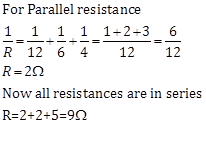
Question 17 (Num)
Calculate the equivalent resistance between the points A and B in the adjacent diagram in the figure.
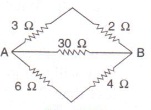
Solution 17 (Num)
R1=3+2 = 5 ohm
R2=30 W
R3=6+4 = 10 ohm
R1 , R2 and R3 are connected in parallel

Question 18 (Num)
In the network shown in adjacent figure, calculate the equivalent resistance between the points (a) A and B (b) A and C
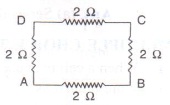
Solution 18 (Num)
(a) R1=2+2+2 = 6ohm
R2=2ohm
R1 and R2 are connected in parallel

(b) R1=2+2 = 4 ohm
R2=2+2=4 W
R1 and R2 are connected in parallel

Question 19 (Num)
Five resistors, each 3 ohm, are connected as shown in figure . Calculate the resitance (a) between pionts P and Q (b) between points X and Y.
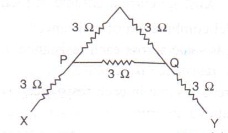
Solution 19 (Num)
(a) R1=3+3=6 W
R2=3 W
R1 and R2 are connected in parallel

(b) As calculated above R=2 ohm
R3 = 3 ohm
R4 = 3 ohm
R’=R+R3+R4=2+3+3 = 8 ohmQuestion 20 (Num)
Two resistors of 2 ohm and 3 ohm are connected (a) in series, (b) in parallel, with a battery of 6.0 V and negligible internal resistance. For each case draw a circuit diagram and calculate the current through battery.Solution 20 (Num)
(a)
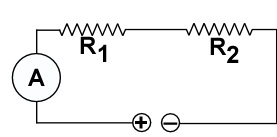
R1=2 ohm
R2=3 ohm
R = R1 + R2 = 2 + 3 = 5 ohm
V=6 V

(b)

R1 and R2 are connected in parallel

Question 21 (Num)
A resistor of 6 ohm is connected in series with another resistor of 4 ohm. A potential difference of 20 V is applied across the combination. (a) Calculate the current in the circuit and (b) potential difference across the 6 ohm resistor.Solution 21 (Num)
(a)
R1=6 ohm
R2=4 ohm
R = R1 + R2 = 6 + 4 = 10 ohm
V=20 V
I=V/R = 20/10 = 2 A
(b) R = 6 W
I = 2 A
V = ?
V = IR = 6 x 2 = 12 VQuestion 22(Num)
Two resistors of resistance 4 Ω and 6 Ω are connected in parallel to a cell to draw 0.5 A current from the cell.
- Draw a labeled diagram of the arrangement
- Calculate current in each resistor.
Solution 22(Num)
a. Circuit diagram
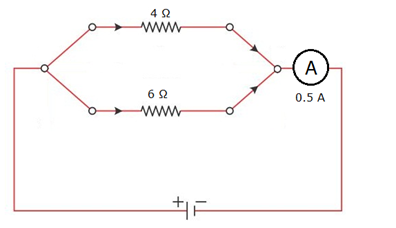
b. Equivalent resistance of the circuit:

Hence, the emf of the cell is

Therefore, current through each resistor is

Question 23(Num)
Calculate current flowing through each of the resistors A and B in the circuit shown in figure?
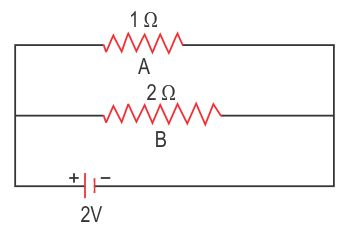
Solution 23(Num)
For resistor A :
R=1 ohm
V=2 V
I=V/R = 2/1 = 2A
For resistor B :
R = 2 ohm
V = 2 V
I=V/R = 2/2 = 1AQuestion 24(Num)
In figure, calculate :
(a) the total resistance of the circuit.
(b) the value of R, and
(c) the current flowing in R
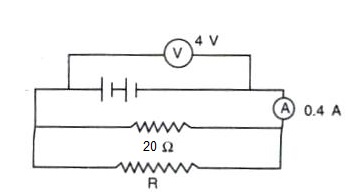
Solution 24(Num)
(a)
V=4 V
I=0.4 A
Total Resistance R’=?
R’ = V/I = 0.4/4 = 10 ohm
(b)
R1= 20 ohm
R’ = 10 ohm

(c)
R=20 ohm
V=4 V
I=V/R = 4/20 = 0.2 AQuestion 25 (Num)
A particular resistance wire has a resistance of 3 ohm per meter. Find :
(a) The total resistance of three lengths of this wire each 1.5 m long, in parallel.
(b) The potential difference of the battery which gives a current of 2 A in each of the 1.5 m length when connected in the parallel to the battery (assume that resistance of the battery is negligible).
(c) The resistance of 5 m length of a wire of the same material, but with twice the area of cross section.Solution 25 (Num)
(a)
Resistance of 1m of wire = 3 ohm
Resistance of 1.5 m of wire = 3 x 1.5 = 4.5 W

(b)
I=2 A
V=IR = 2 x 4.5 = 9 V
(c)
R=3 ohm for 1 m
For 5 m : R=3 x 5 = 15 ohm
But Area A is double i.e. 2A and Resistance is inversely proportional to area so Resistance will be half.
R=15/2 = 7.5 ohmQuestion 26 (Num)
A cell supplies a current of 1.2 A through two 2 ohm resistors connected in parallel. When resistors are connected in series, it supplies a current of 0.4 A. Calculate: (i) the internal resistance and (ii) e.m.f. of the cell.Solution 26 (Num)
In parallel R = ½ + ½ = 1 ohm
I = 1.2 A
![]() =I(R+r) = 1.2(1+r)= 1.2 + 1.2 r
=I(R+r) = 1.2(1+r)= 1.2 + 1.2 r
In series R = 2+2=4 ohm
I=0.4 A
![]() =I(R+r) = 0.4(4+r) = 1.6 + 0.4 r
=I(R+r) = 0.4(4+r) = 1.6 + 0.4 r
It means :
1.2 + 1.2 r = 1.6 + 0.4 r
0.8 r = 0.4
r = 0.4 / 0.8 = ½ = 0.5 ohm
(i) Internal resistance r = 0.5 ohm
(ii) ![]() =I(R+r) = 1.2(1+0.5) = 1.8 VQuestion 27 (Num)
=I(R+r) = 1.2(1+0.5) = 1.8 VQuestion 27 (Num)
A battery of emf 15 V and internal resistance 3 ohm is connected to two resistors 3 ohm and 6 ohm connected in parallel. Find (a) the current through the battery (b) p.d. between the terminals of the battery (c) the current in 3 ohm resistor (d) the current in 6 ohm resistor.Solution 27 (Num)
(a)In parallel 1/R = 1/3 + 1/6 = 1/2
So R = 2 ohm
r = 3 W
![]() =15 V
=15 V
![]() =I(R+r)
=I(R+r)
15=I(2+3)
I=15/5 = 3 A
(b)V=?
R=2 ohm
V=IR = 3 x 2 = 6 V
(c)V=6 V
R = 3 ohm
I=V/R = 6/3 = 2 A
(d) R=6 ohm
V= 6 V
I=V/R = 6/6 = 1 AQuestion 28 (Num)
The following circuit diagram shows three resistors 2 ![]() , 4
, 4 ![]() and R
and R![]() connected to a battery of e.m.f. 2 V and internal resistance 3
connected to a battery of e.m.f. 2 V and internal resistance 3 ![]() . A main current of 0.25 A flows through the circuit.
. A main current of 0.25 A flows through the circuit.
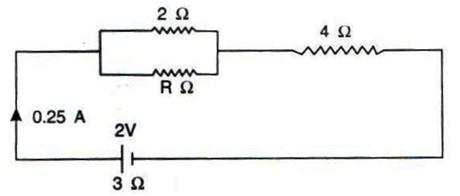
(a) What is the p.d. across the 4 ohm resistor?
(b) Calculate the p.d. across the internal resistance of the cell.
(c) What is the p.d. across the R ![]() or 2
or 2 ![]() resistor?
resistor?
(d) Calculate the value of R.Solution 28 (Num)
(a)R = 4 ![]()
I = 0.25 A
V=IR = 0.25 x 4 = 1 V
(b)Internal Resistance r=3 ohm
I = 0.25 A
V=IR = 0.25 x 3 = 0.75 V
(c) Effective resistance of parallel combination of two 2 ohm resistances = 1 ohm
V= I/R = 0.25/1 = 0.25 V
(d) I=0.25 A
![]() =2V, r = 3 ohm
=2V, r = 3 ohm
![]() =I(R’+r)
=I(R’+r)
2=0.25(R’+3)
R’=5 W

Question 29 (Num)
Three resistors of 6.0 ohm, 2.0 ohm and 4.0 ohm are joined to ammeter A and a cell of emf 6.0 V as shown in figure. Calculate :
(a) the efective resistance of the circuit.
(b) the reading of ammeter
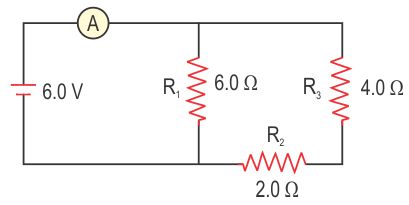
Solution 29 (Num)
(a) R1=6 W
R’=R2+R3=2+4=6 W
R1 and R’ in parallel :

(b) R= 3 ohm
V=6 V
I=?
I=V/R=6/3=2 AQuestion 30(Num)
The diagram below in Fig., shows the arrangement of five different resistances connected to a battery of e.m.f. 1.8 V. Calculate :
a. The total resistance of the circuit
b. The reading of ammeter A.
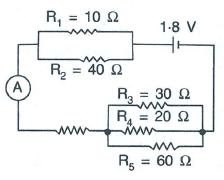
Solution 30(Num)
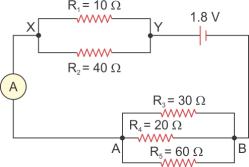

Question 31(Num)
A cell of e.m.f. 2 V and internal resistance 1.2 Ω is connected to an ammeter of resistance 0.8 Ω and two resistors of 4.5 Ω and 9 Ω as shown in fig.

Find:
- The reading of the ammeter,
- The potential difference across the terminals of the cells, and
- The potential difference across the 4.5 Ω resistor.
Solution 31(Num)
The total resistance of the circuit is

a. Therefore, the current through the ammeter is

b. The potential difference across the ends of the cells is

c. The potential difference across the 4.5 Ω resistor is

Chapter 8 – Current Electricity Exercise Ex. 8A
Exercise Ex. 8C
Chapter 8 – Current Electricity Exercise Ex. 8C
Question 1
Write an expression for the electrical energy spent in flow of current through an electrical appliance in terms of current, resistance and time.Solution 1

Question 1 (MCQ)
When a current I flows through a resistance R for time t, the electrical energy spent is given by :
(a) IRt
(b) I2Rt
(c) IR2t
(d) I2R/t Solution 1 (MCQ)
I²Rt
Note:

Question 1 (Num)
An electric bulb of resistance 500 Ω draws current 0.4 A from the source. Calculate: (a) the power of bulb and (b) the potential difference at its end.Solution 1 (Num)
Resistance of electric bulb (R) = 500Ω
Current drawn from the source (I) = 0.4 A
Power of the bulb (P) = VI
V = I x R
V = 0.4 x 500 = 200 V
The potential difference at its end is 200 V.
Hence,
Power (P) = VI
P = 200 x 0.4 = 80 W
The power of the bulb is 80 Watt.Question 2
Write an expression for the electrical power spent in flow of current through a conductor in terms of (a) resistance and potential difference, (b) current and resistance.Solution 2

Question 2 (MCQ)
An electrical appliance has a rating 100 W, 120V. The resistance of element of appliance when in use:
(A) 1.2
(B) 144
(C) 120
(D) 100 Solution 2 (MCQ)
144
Solution:

Question 2 (Num)
A current of 2 A is passed through a coil of resistance 75 Ω for 2 minutes. (a) How much heat energy is produced? (b) How much charge is passed through the resistance?Solution 2 (Num)

Question 3
Electrical power P is given by the expression![]()
(a)What do the symbols Q and V represent?
(b)Express the power P in terms of current and resistance explaining the meanings of symbols used there in.Solution 3
(a)Q represents Charge and V represents Voltage.
(b)

Question 3 (Num)
Calculate the current through a 60 W lamp rated 250 V. If the line voltage falls to 200 V, how is power consumed by the bulb affected?Solution 3 (Num)

Question 4
Name the S.I. unit of electrical energy. How is it related to Wh?Solution 4
The S.I. unit of electrical energy is joule.
1Wh = 3600 JQuestion 4 (Num)
An electric bulb is rated ‘100 W, 250 V’. How much current will the bulb draw if connected to a 250 V supply?Solution 4 (Num)

Question 5
Explain the meaning of the statement ‘the power of an appliance is 100 W’.Solution 5
The power of an appliance is 100 W. It means that 100 J of electrical energy is consumed by the appliance in 1 second.Question 5 (Num)
An electric bulb is rated at 220 V, 100 W. (a) What is its resistance? (b) What safe current can be passed through it?Solution 5 (Num)

Question 6
State the S.I. units of electrical power.Solution 6
The S.I. unit of electrical power is Watt. Question 6 (Num)
A bulb of 40 W is used for 12.5 h each day for 30 days. Calculate the electrical energy consumed.Solution 6 (Num)

Question 7
(i)State and define the household unit of electricity.
(ii)What is the voltage of the electricity that is generally supplied to a house?
(iii) What is consumed while using different electrical appliances, for which electricity bills are paid?
(iiiSolution 7
(i)The household unit of electricity is kilowatt-hour (kWh).
One kilowatt-hour (kWh) is the electrical energy consumed by an electrical appliance of power 1 kW when it is used for one hour.
(ii)The voltage of the electricity that is generally supplied to a house is 220 Volt.
Electri (iii) electrical energy is consumed.
iiiQuestion 7 (Num)
An electric iron is rated 750 W, 230 V. Calculate the electrical energy consumed by the iron in 16 hours.Solution 7 (Num)

Question 8
Name the physical quantity which is measured in (i) kW, (ii) kWh. (iii) WhSolution 8
(i)Electrical power is measured in kW and
(ii)Electrical energy is measured in kWh.Question 8 (Num)
An electrical appliance having a resistance of![]() is operated at 220 V. calculate the energy consumed by the appliance in 5 minutes. (i) in joules (ii) in kWh.Solution 8 (Num)
is operated at 220 V. calculate the energy consumed by the appliance in 5 minutes. (i) in joules (ii) in kWh.Solution 8 (Num)

Question 9
Define the term kilowatt – hour and state its value in S.I. unit.Solution 9
One kilowatt-hour (kWh) is the electrical energy consumed by an electrical appliance of power 1 kW when it is used for one hour.
Its value in SI unit is ![]() Question 9 (Num)
Question 9 (Num)
A bulb marked 12 V, 24 W operates on a 12 V battery for 20 minutes. Calculate:
(i)The current flowing through it, and
(ii)The energy consumed.Solution 9 (Num)

Question 10
Distinguish between kilowatt and kilowatt-hour.Solution 10
Kilowatt is the unit of electrical power whereas kilowatt-hour is the unit of electrical energy.Question 10 (Num)
A current of 0.2 A flows through a wire whose ends are at a potential difference of 15 V. Calculate:
(i)The resistance of the wire, and
(ii)The heat energy produced in 1 minute.Solution 10 (Num)

Question 11
Complete the following:
(a)

(b)
1 kWh= ________ JSolution 11
(a)

(b) 3.6 x 106 JQuestion 11 (Num)
What is the resistance, under normal working conditions, of an electric lamp rated at ‘240 v’, 60 W? If two such lamps are connected in series across a 240 V mains supply, explain why each one appears less bright.Solution 11 (Num)

When one lamp is connected across the mains, it draws 0.25 A current, while if two lamps are connected in series across the mains, current through each bulb becomes![]()
(i.e., current is halved), hence heating (![]() ) in each bulb becomes one-fourth, so each bulb appears less bright.Question 12
) in each bulb becomes one-fourth, so each bulb appears less bright.Question 12
What do you mean by power rating of an electrical appliance? How do you use it to calculate (a) the resistance of the appliance and (b) the safe limit of the current in it, while in use?Solution 12
An electrical appliance such as electric bulb, geyser etc. is rated with power (P) and voltage (V) which is known as its power rating. For example: If an electric bulb is rated as 50W-220V, it means that when the bulb is lighted on a 220 V supply, it consumes 50 W electrical power.
(a) To calculate the resistance of the appliance, the expression is:

(b) The safe limit of current I is: ![]() Question 12 (Num)
Question 12 (Num)
Two bulbs are rated 60 W, 220 V and 60 W, 110 V respectively. Calculate the ratio of their resistances.Solution 12 (Num)

Question 13
An electric bulb is marked ‘100 W, 250 V’. What information does this convey?Solution 13
It means that if the bulb is lighted on a 250 V supply, it consumes 100 W electrical power (which means 100J of electrical energy is converted in the filament of bulb into the light and heat energy in 1 second).Question 13 (Num)
An electric bulb is rated 250 W, 230 V.
(i) the energy consumed in one hour, and
(ii) the time in which the bulb will consume 1.0 kWh energy when connected to 230 V mains?Solution 13 (Num)

Question 14
List the names of three electrical gadgets used in your house. Write their power, voltage rating and approximate time for which each one is used in a day. Hence find the electrical energy consumed by each in day.Solution 14
| Appliance | Power(in watt) | Voltage(in volts) | Time( hours) | Electrical energy |
| Fluorescent tubeTelevision setRefrigerator | 40120150 | 220220220 | 12424 | 0.48 kWh0.48 KWh3.6 kWh |
Question 14 (Num)
Three heaters each rated 250 W, 100 V are connected in parallel to a 100 V supply. Calculate:
(i)The total current taken from the supply,
(ii)The resistance of each heater, and
(iii)The energy supplied in kWh to the three heaters in 5 hours.Solution 14 (Num)

Question 15
Twolamps, one rated 220 V, 50 W and the other rated 220 V, 100 W, are connected in series with mains of 220 V. Explain why does the 50 W lamp consume more power.Solution 15

Question 15 (Num)
A bulb is connected to a battery of p.d. 4 V and internal resistance![]() . A steady current of 0.5 A flows through the circuit. Calculate:
. A steady current of 0.5 A flows through the circuit. Calculate:
(i)The total energy supplied by the battery in 10 minutes,
(ii)The resistance of the bulb, and
(iii)The energy dissipated in the bulb in 10 minutes.Solution 15 (Num)

Question 16
Name the factors on which the heat produced in a wire depends when current is passed in it, and state how does it depend on the factors stated by you.Solution 16
When current is passed in a wire, the heat produced in it depends on the three factors: (i) on the amount of current passing through the wire, (ii) on the resistance of wire and (iii) on the time for which current is passed in the wire.
(i)Dependence of heat produced on the current in wire: The amount of heat H produced in the wire is directly proportional to the square of current I passing through the wire, i.e.,![]()
(ii)Dependence of heat produced on the resistance of wire: The amount of heat H produced in the wire is directly proportional to the resistance R of the wire, i.e.,![]()
(iii)Dependence of heat produced on the time: The amount of heat H produced in the wire is directly proportional to the time t for which current is passed in the wire, i.e.,![]() Question 16 (Num)
Question 16 (Num)
Two resistors A and B of![]() and
and ![]() respectively are connected in parallel. The combination is connected across a 6 volt battery of negligible resistance. Calculate: (i) the power supplied by the battery, (ii) the power dissipated in each resistor.Solution 16 (Num)
respectively are connected in parallel. The combination is connected across a 6 volt battery of negligible resistance. Calculate: (i) the power supplied by the battery, (ii) the power dissipated in each resistor.Solution 16 (Num)

Question 17 (Num)
A battery of e.m.f. 15 V and internal resistance![]() is connected to two resistors of 4 ohm and 6 ohm joined (a) in series. Find in each case the electrical energy spent per minute in
is connected to two resistors of 4 ohm and 6 ohm joined (a) in series. Find in each case the electrical energy spent per minute in![]() resistor.Solution 17 (Num)
resistor.Solution 17 (Num)

Question 18 (Num
Water in an electric kettle connected to a 220 V supply took 5 minutes to reach its boiling point. How long would it have taken if the supply had been of 200 V?Solution 18 (Num

Question 19 (Num)
An electric toaster draws 8 A current in a 220 V circuit. It is used for 2 h. Find the cost of operating the toaster if the cost of electrical energy is Rs. 4.50 per kWh.Solution 19 (Num)

Question 20 (Num)
An electric kettle is rated 2.5 kW, 250 V. Find the cost of running the kettle for two hours at Rs. 5.40 per unit.Solution 20 (Num)

Question 21 (Num)
A geyser is rated 1500 W, 250 V. This geyser is connected to 250 V mains. Calculate:
(i)The current drawn,
(ii)The energy consumed in 50 hours, and
(iii)The cost of energy consumed at Rs 4.20 per kWh.Solution 21 (Num)
